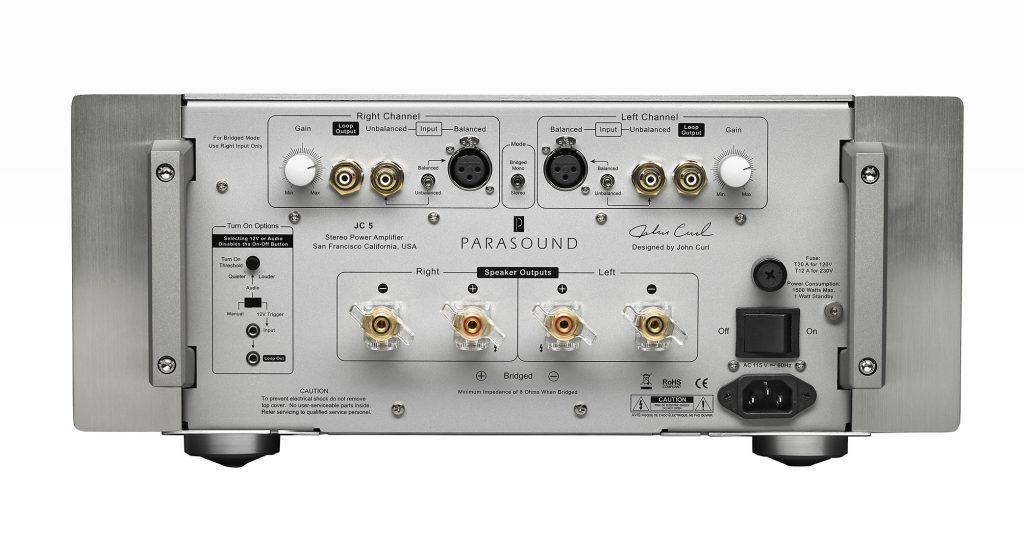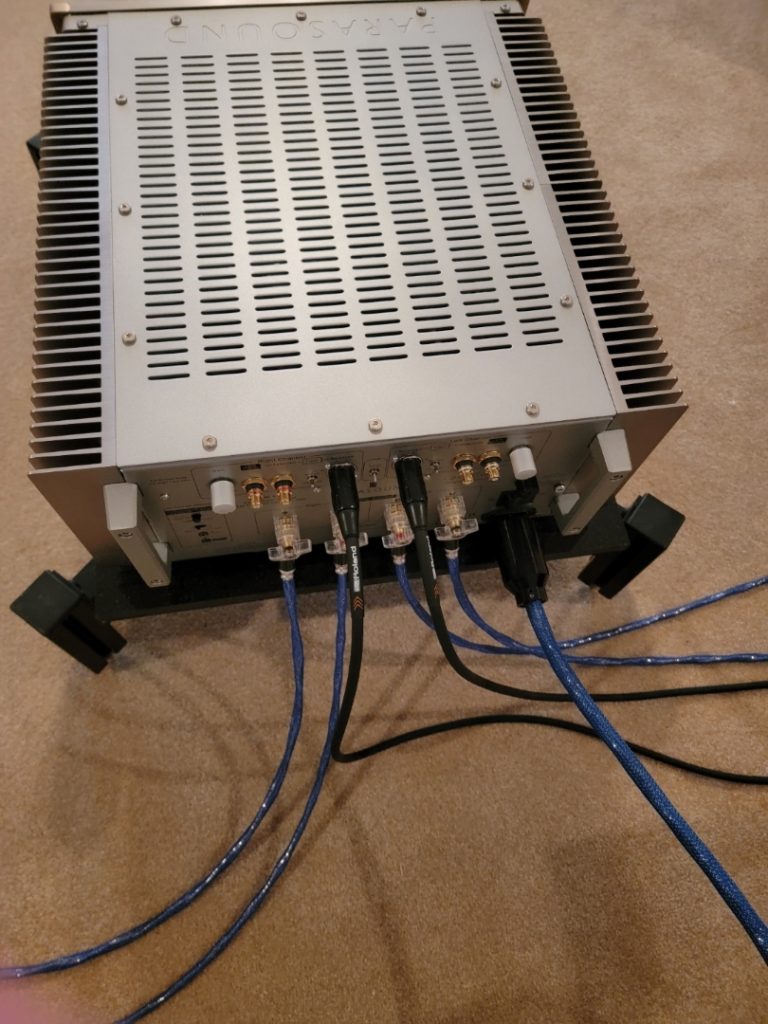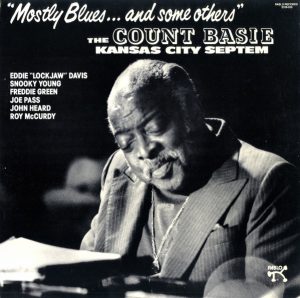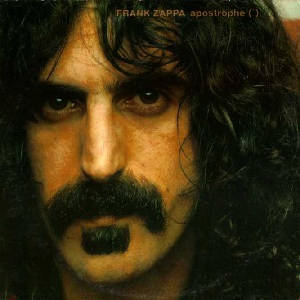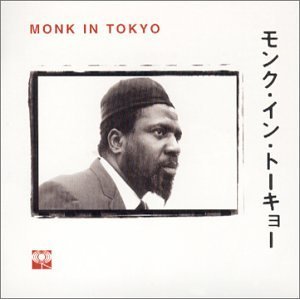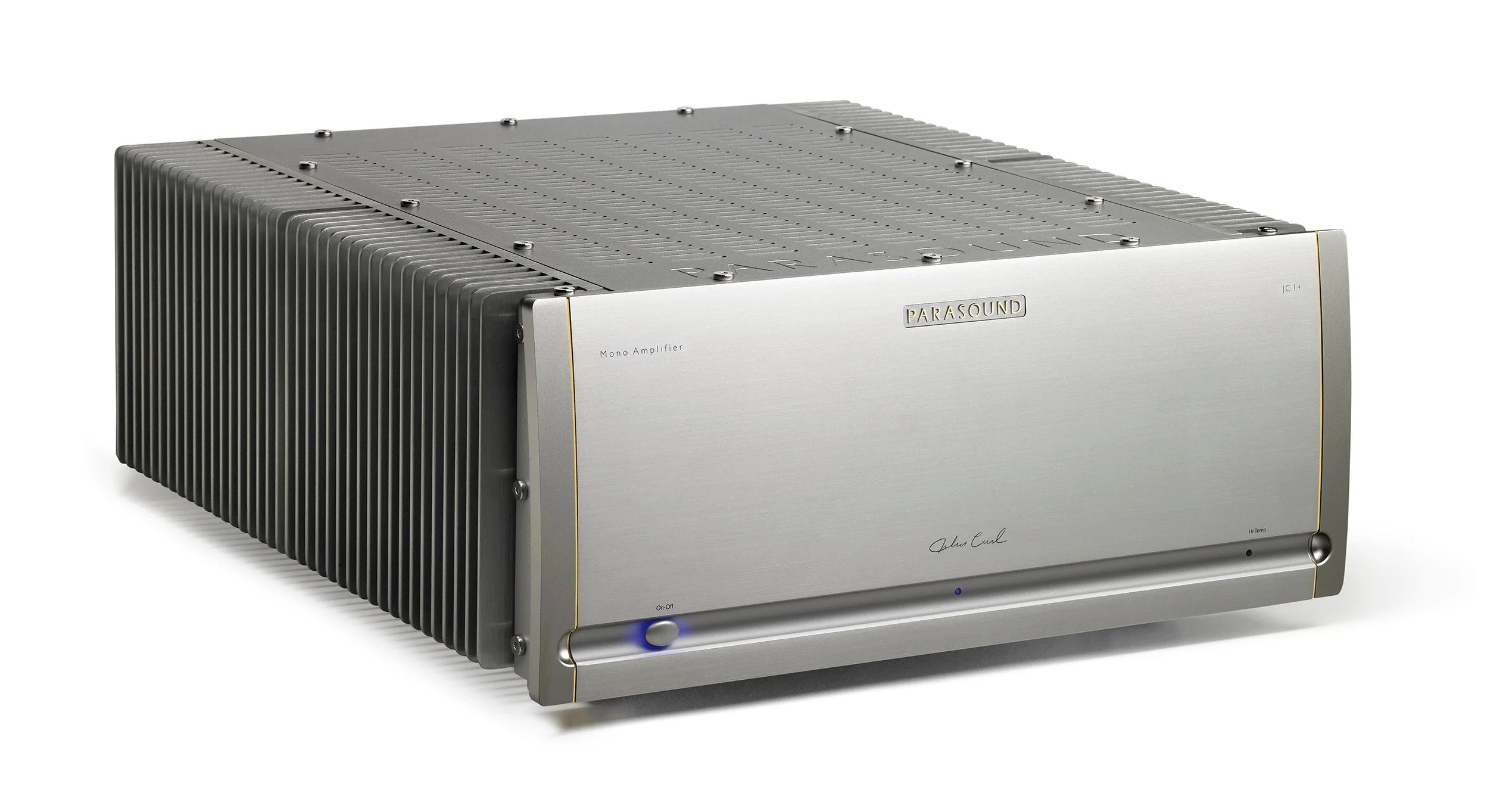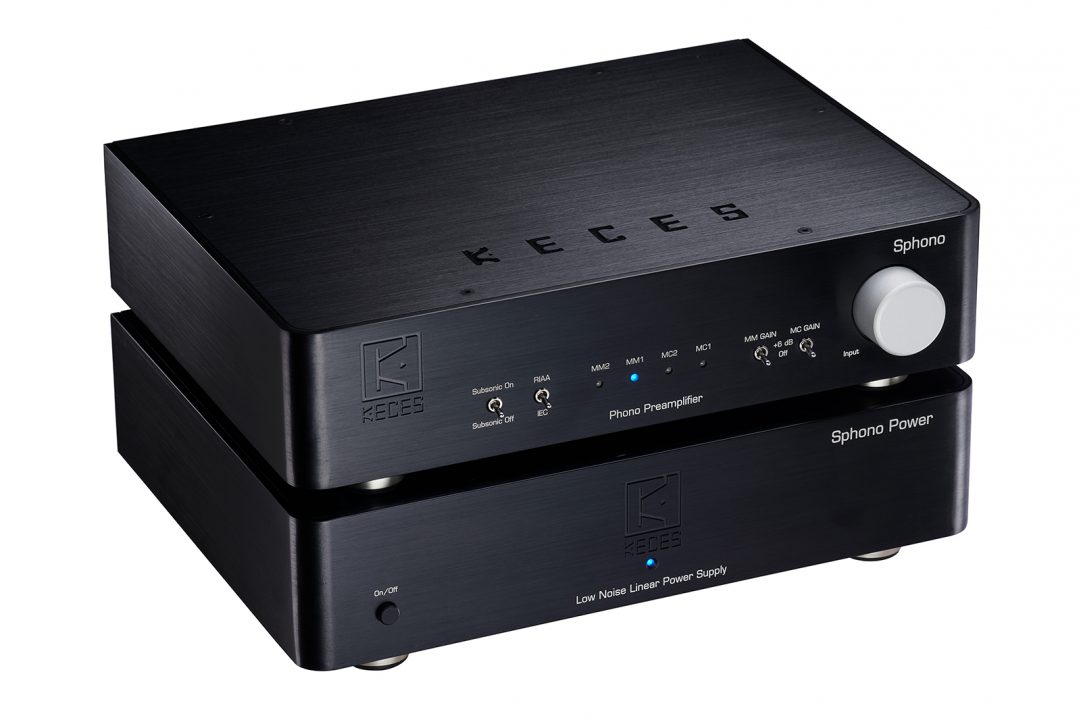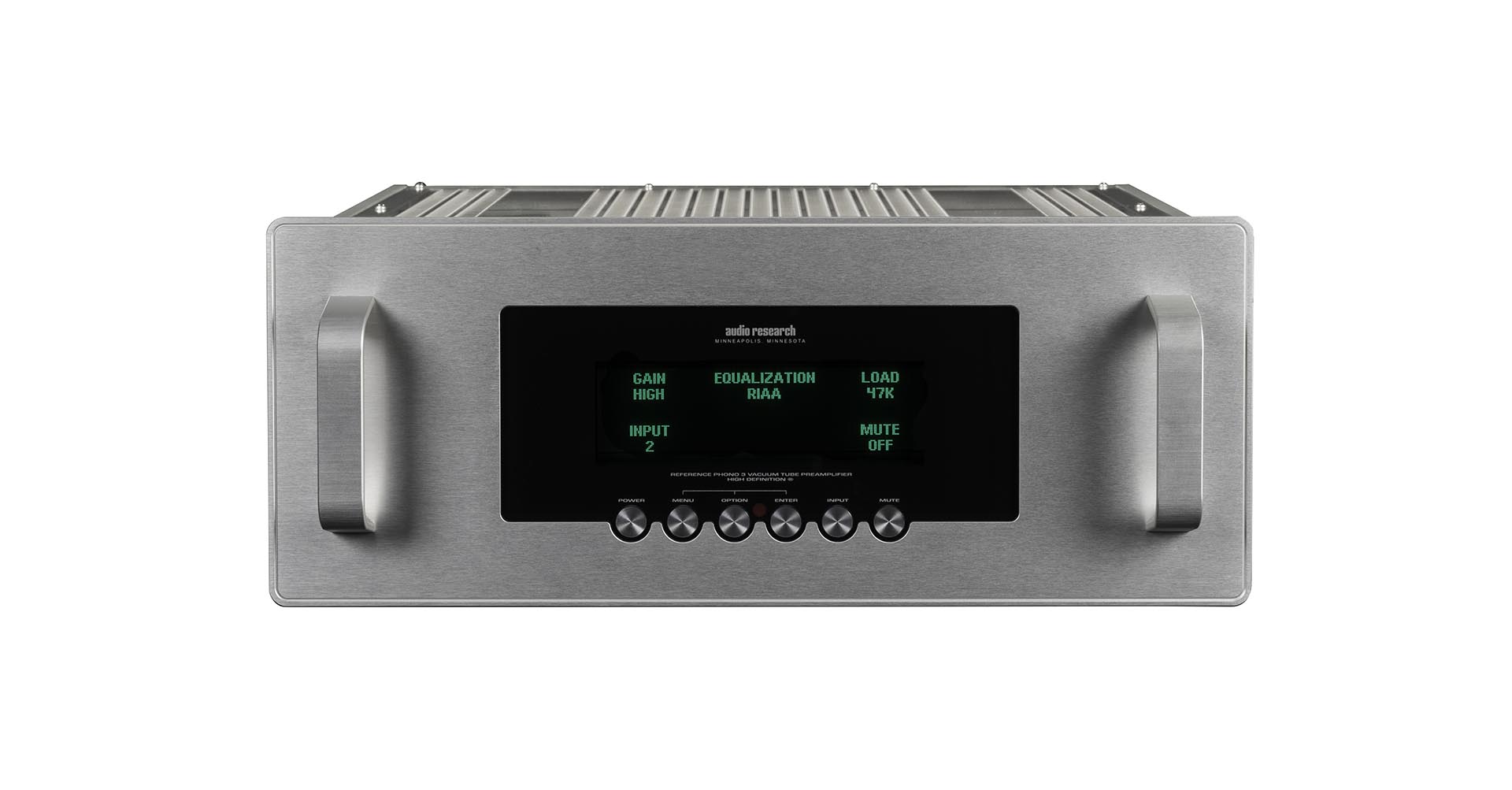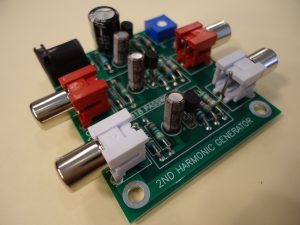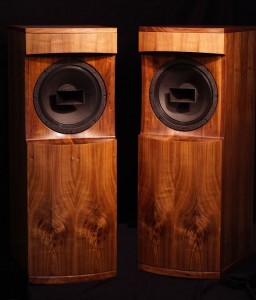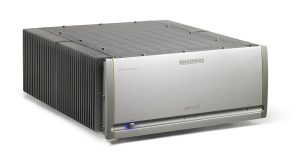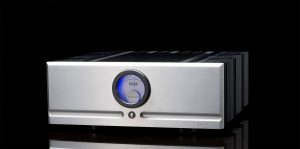The Parasound JC 5 stereo amplifier has been in continuous production since 2018 and has been reviewed many times over the years including reviews in Positive Feedback. I want to be upfront that I purchased the JC 5 prior to writing this review. I made the leap of faith based on the reputation of the amp's designer, who happens to be John Curl, who is widely regarded as one of the best engineers designing solid-state audio gear. The specifications for the JC 5 are quite impressive (this is not the full list):
- Power Output (stereo): 400 watts x2, 8 ohm both channels driven. 600 watts x2, 4 ohm both channels driven
- Current Capacity: 90 amps peak, per channel
- Slew Rate: 130 volts per microsecond
- Frequency Response: 5Hz – 100kHz +0/-3dBdB. 20Hz – 20kHz +0/-0.25dB
- Total Harmonic Distortion (THD): <0.05% at full power. <0.03% at typical listening levels
- IM Distortion: <0.04%
- TIM: Unmeasurable
If you want to see the full list of specifications go HERE.
The JC 5 can be used in bridged mono mode for an output power of 1200 watts into 8 ohms, and a 4 ohm load is not recommended for bridged mode. I reviewed this as a stereo amplifier, which is how I believe the majority of buyers are using it.
The JC 5 is a truly balanced amplifier, and I drove it in balanced mode with my Ref 6 linestage, which is also balanced. Setup of the JC 5 is very straight forward. There are two switches on the top of the rear panel that have to be flipped to balanced mode when using the XLR balanced inputs. There are 2 gain controls that I turned to the max gain position. You have various turn on options with the JC 5, but I set the switch to the manual position because I leave the JC 5 on 24/7. Next up is connecting the speaker cables to the CHK Infinium 5-way custom binding posts, and finally installing the power cord. There is a power switch on the rear panel and it must be turned on prior to pushing the power button on the bottom left of the front panel.
Once the power button on the front of the JC 5 is turned on, the JC 5 goes through a brief warm up and the light on the power button switches to blue and the two indicator lights for the right and left channel turn blue as well, which indicates normal operation of both channels. There is also a Hi Temp Indicator light on the front panel that "will glow red if any channel overheats" according to the owner's manual. I have never seen that red light, and I don't expect I ever will.
The rest of my system used in this review:
- Roon Nucleus+
- HiFi Rose 150B
- Micro Seiki SX-8000 table with the Micro Seiki High Speed Inertia Unit (fly wheel)
- SME 3012R arm with the Lyra Etna SL cartridge
- ARC Ref 3 phono preamp
- ARC Ref 6 linestage
- JBL 4345 speakers
- Definitive Technology Ref subs (2)
I started the break in of the JC 5 using the power cable supplied with the amp and using my reference Viero Equilibrio Level 3 speaker cables. It didn't take long to realize how neutral the JC 5 is. The JC 5 is true to the source material you play through it. If you are playing albums that have weak bass, the JC 5 is not going to change it to thunderous bass. If you have recordings with really deep and powerful bass, you will hear every note of it. If you play a multi-track recording and the singer was recorded in a broom closet, it's going to sound like the singer was recorded in a broom closet. The truth is that the JC 5 is holding up a mirror to the rest of your system. Good recordings will sound good, bad recordings will sound bad, and great recordings will sound great.
The biggest thing I noticed right away with the JC 5 in comparison to my long term reference amp (ARC Ref 75) was the soundstage height increased with the JC 5, making the soundstage more realistic. As the amp broke in, the JC 5 continued to increase the dimensions of the soundstage in all directions.
After I had listened to the JC 5 for several months, I reached out to Olu Sonuga from Dynamic Design AV cables. I wanted to use the Lotus GS speaker cables that he had previously sent me as part of the full loom of Dynamic Design AV that I reviewed for Positive Feedback. The Lotus GS speaker cables made a profound difference in the sound of my system using the ARC Ref 75 amp and my JBL 4345 speakers. You can read my review of the Dynamic Design AV Lotus loom of cables HERE.
Olu agreed to send me a 2.5 meter pair of the Lotus GS speaker cables with spade lugs at each end. Olu asked me if I wanted a Lotus GS analog power cable to use with the JC 5 too, and I accepted his offer and then asked while we were at it, how about the Spirit GS digital power cable that I had previously used on my HiFi Rose 150B DAC? Olu was kind enough to send me all three cables, and I used all three of the Dynamic Design cables for the duration of my review of the JC 5.
Because the JC 5 is so neutral, it can be difficult to describe things that you hear in the music that are unique to the JC 5 and not a reflection of all of your upstream components and sources. The JC 5 is truly a chameleon in a neutral system. What I will say is that the JC 5 brings more realism to the table, and it expands the envelope of the dynamic range on really good recordings that contain a lot of dynamic range. The soundstage with the JC 5 becomes bigger in all dimensions with increased spatiality of sounds within the expanded boundaries of the soundstage.
The Count Basie Kansas City Septum Mostly Blues…and Some Others (Pablo Records) is a phenomenal sounding LP. Count Basie has a big left hand which means he plays lots of bass, which is thrilling to hear if you like the sound of a piano playing full range. My notes from listening to this LP said the JC 5 brings music to life. "Blues For Charlie Christian" has a walking bass line on piano and John Head on acoustic bass that sounds incredibly real. This song energized my entire room.
For a little fun, I played my copy of Frank Zappa Apostrophe (DiscReet LP). This has always been a really good sounding LP that is packed with captivating sounding music, sound effects, and hilarious lyrics in a style unique to Frank Zappa. With the JC 5, there is more there to be heard and this LP is stunning in dynamics and frequency extension.
Switching to digital, one of my favorite live jazz recordings is by The Thelonious Monk Quartet Monk In Tokyo (16/44.1 Quobuz). "Straight No Chaser" has incredibly realistic drum sound and dynamics and that holds up across the entire album. The tenor sax played by Charlie Rouse sounds like you are there, it's so real. The acoustic bass played by Butch Warren puts meat on the bass bones. I'm a sucker for great walking bass lines, and this song has a really good example. There is also really good pitch definition of the bass and decay of the bass notes. The drum solo at the end of the song is off the charts real sounding. Frankie Dunlop is an incredibly dynamic drummer, and the JC 5 lets it all come to life.
Towards the end of this review, I had the pleasure of calling John Curl to talk to him about the JC 5 and many other topics that came up during our discussion. It was a blast to talk to John, he is very funny, very honest, and has a deep knowledge of all the players involved in high end audio.
I asked John what his design goals were for the JC 5, and he responded by saying that it was a cost effective design for those who can't afford the JC 1+. The JC 1+ is dual mono, and is built with more expensive parts that include custom made Nichion capacitors, and has more pure Class A output power (25-watts vs. 12-watts for the JC 5) due to having twice the heat sink capacity as well as having two power transformers versus one for the JC 5.
I also asked John how slew rate affects the sound of an amplifier. John went into a dissertation about the history of slew rate evolution. Back in the 1970s, 5v/ms used to be normal because the original op amps used then had a very slow slew rate. Matti Otala jumped it up to 100v/ms, which became the gold standard. John said that once the slew rate meets the 100v/ms standard, it imparts a sense of effortlessness to the sound.
In conclusion of my review of the JC 5, I'm very happy with my purchase decision. It's hard for me to imagine a speaker this amp can't drive. With the JBL 4345s being a nominal 8 ohm load with a sensitivity of 95dB 1w/1m, the JC 5 is overkill for me power wise, which I'm fine with. I can achieve 104dB SPL with just 8 watts, which is well within the 12 watts of pure Class A power available, and also well beyond my average listening levels. For everything the JC 5 offers, I find it to be an incredible bargain.
JC 5 Amplifier
Retail: $6399
Parasound
415.397.7100





